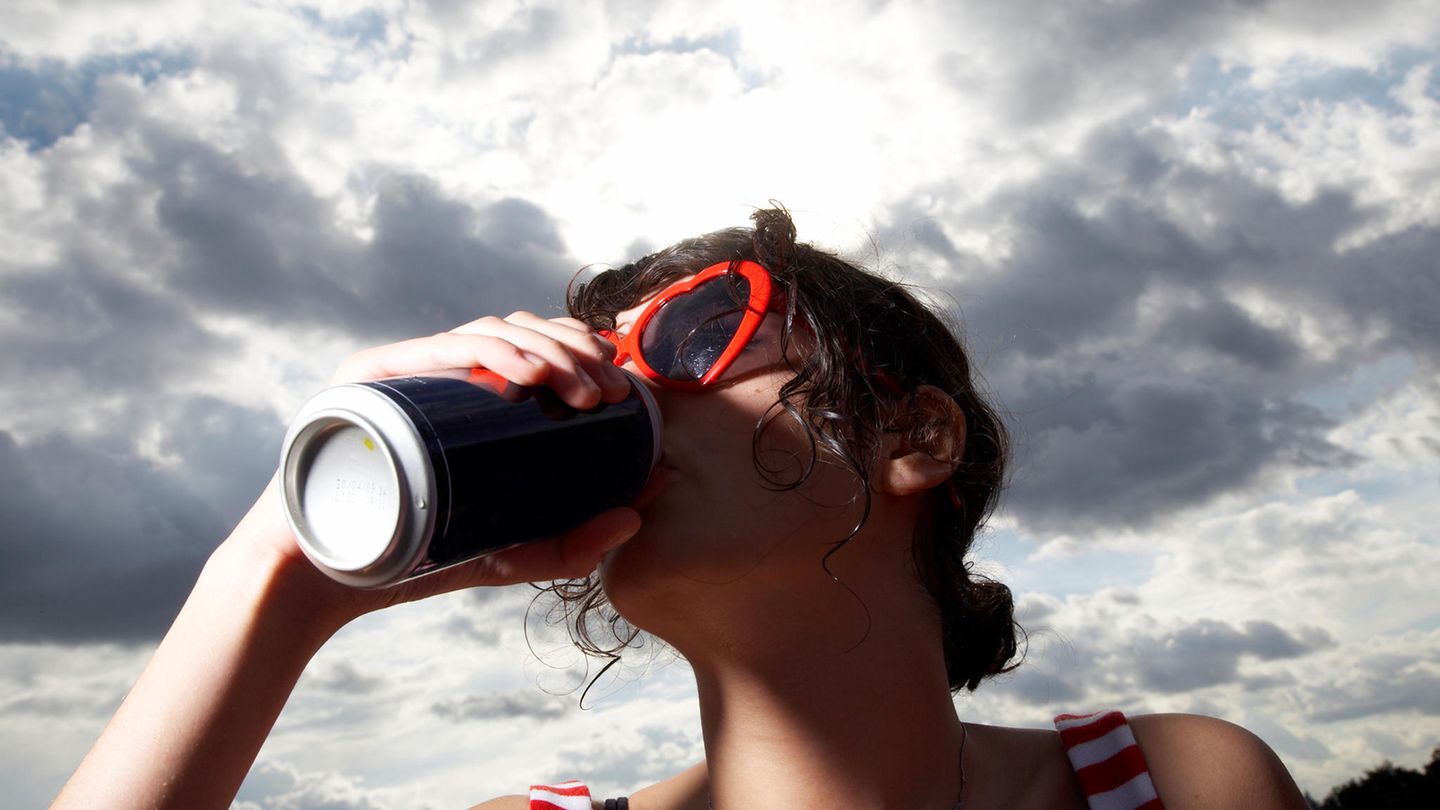Dangerous enjoyment
This is how much alcohol increases the risk of cancer
Copy the current link
Did you know that alcoholic drinks increase the risk of developing cancer? A US report shows how the risk increases as the quantity increases.
Does the year start with “Dry January” for you too? Then you are in good company. January is considered the most popular month for abstaining from alcohol – and there is a good reason for this: Germans rarely drink more alcohol than in the last weeks of the year. Mulled wine at the Christmas market, beer at the Christmas party, maybe a gin and tonic later. There is red wine with the goose, then white wine on Christmas Day. The second one doesn’t remain without alcohol either. The toast takes place in the afternoon anyway – after all, we haven’t seen each other for a long time. New Year’s Eve is often the culmination of the alcohol-heavy winter days.
But even during the rest of the year, most people don’t exactly shine with abstinence: the average German drinks a full ten liters of pure alcohol per year by the time they come of age at the latest. This corresponds to around 450 bottles of beer or 100 bottles of wine.
What few people are aware of, however, is that with every drink you increase your risk of later developing cancer. A report now warns that alcohol consumption makes these seven types of tumors more likely: mouth cancer, throat cancer, larynx cancer, esophageal cancer, breast cancer, liver cancer and colon and rectal cancer.
More than 20,000 new cancer cases in Germany due to alcohol
Vivek Murthy, the top US medical officer who heads the US public health service, warns: “Globally, 741,300 cancer cases were attributed to alcohol consumption in 2020.” How great the danger is in Germany is shown. According to this, more than 20,000 new cases of cancer in 2022 could probably be traced back to alcohol consumption – around 14,000 in men and 6,200 in women. At around 45 percent, colon cancer made up the largest proportion of all cancer cases caused by alcohol consumption.
The more alcohol you drink, the greater the risk of cancer – especially if you consume it regularly and over a long period of time. Whether you choose wine, beer or schnapps doesn’t seem to matter. The only thing that matters is the amount of pure alcohol in the drinks. But what does that mean exactly? At what point does it become dangerous? And which risk category do you belong to?
Less than one small alcoholic drink per week
According to data from a 2020 Australian study of nearly a quarter of a million adults, about 16 to 17 out of 100 women who consume one drink a week or less will develop one of the seven cancers during their lifetime. The US report presenting the data defines a standard drink as 14 grams of alcohol – which is roughly equivalent to a small glass of wine or a small bottle of beer. Around 11 out of 100 women who drink this way will develop breast cancer. Of men who consume less than one drink per week, around 10 percent will develop one of the above-mentioned types of cancer over the course of their lives.
In this category, most cancers can be traced back to other causes, such as a genetic predisposition, smoking or an unhealthy diet. However, a harmful effect of alcohol cannot be ruled out, even in small quantities. Research shows there is no safe level of alcohol when it comes to cancer risk.
One small alcoholic drink per day
For years it was assumed that small or moderate amounts of alcohol were hardly harmful. In recent years, however, it has been shown that one drink per day (or seven per week) is indeed associated with health risks. This also includes an increased risk of cancer. The US report states: The lifetime risk of developing alcohol-related cancer increases to 19 percent among those who drink one alcoholic drink a day or seven drinks a week. The lifetime risk of developing breast cancer is 13.1 percent. Thirteen women out of every hundred become ill afterwards, i.e. two more than in the group of those who rarely consume alcohol.
For men who drink one drink a day, an average of 11 out of 100 will develop one of the cancers in their lifetime, which can also be alcohol-related. Although the absolute increase in risk may seem small, it reflects a clear difference compared to people who drink less alcohol.
A 2013 study published in the journal found that people who drank up to one alcoholic drink per day had a 30 percent higher risk of developing esophageal cancer compared to those who did not drink. Another analysis of 26 studies concluded that the relative likelihood of developing oral cancer increases by among those who drink about one alcoholic drink per day. In some studies, the relative risk of breast cancer in women increased by .
Two small alcoholic drinks per day
With two drinks per day (or 14 per week), the proportion of women with alcohol-related cancer increased from 16.5 to almost 22 percent, according to the US report. The proportion of those who develop breast cancer increased from 11 to 15.3 percent. Men who drink to this extent increase the risk of developing cancer, which may also be alcohol-related, to 13 percent over the course of their life. The risk of oral cancer actually doubles for men and women.
Enjoyment without a hangover: These delicious cocktails don’t require any alcohol
Ingredients for 1 glass:
50 g cold wormwood tea
3 ice cubes
200g tonic
1 orange slice
For the wormwood tea:
2 tsp dried wormwood leaves
300 ml boiling water
Preparation:
Pour boiling water over the wormwood tea and let it steep for 5 minutes. Drain the tea and let it cool down, refrigerate. Pour wormwood tea into a highball glass. Add ice cubes and pour in tonic. Put the orange slice in the glass.
Tip:
It is very practical to prepare a large amount of wormwood tea straight away. It lasts for 2 days in the fridge and you always have the crucial ingredient for the vermouth tonic on hand – or better yet, in a glass.
© Stefan Mayer/Brandstätter Verlag
Back
Further
All of this data makes it clear that the risk of cancer for someone who has one or two small drinks per week is significantly lower than for someone who has one or two drinks per day. Awareness of this risk is particularly important for those who already have an increased risk of cancer due to their family history, genetic predisposition or environmental influences.
And something else is evident: it takes less alcohol to affect women’s health than men’s. The explanation may be that women take longer to metabolize alcohol and it stays in their bodies longer.
Four theories on how alcohol can cause cancer
One final question remains: Why does alcohol actually increase the risk of cancer? Although there is no clear answer to this, there are four possible explanations.
- Alcohol is broken down into acetaldehyde in the body. This substance is very reactive and easily forms bonds with other molecules, including building blocks of the genetic material. This can lead to direct mutations, i.e. errors in the “blueprint”. Changes are also possible that do not destroy the genetic information itself, but influence the reading of genes and can thus also promote the development of cancer.
- Alcohol produces reactive oxygen species that increase inflammation and damage the DNA, proteins, and lipids (fat components) in the body through a process called oxidation.
- Alcohol alters the amounts and effects of various sex hormones, including estrogen, which may explain the increased risk of breast cancer in women who regularly drink alcohol.
- Carcinogens (cancer-causing molecules) from other sources, especially tobacco smoke particles, can dissolve in alcohol, making them easier to absorb into the body. This could increase the risk of mouth and throat cancer, according to the US report.
Source: Stern
I’m Caroline, a journalist and author for 24 Hours Worlds. I specialize in health-related news and stories, bringing real-world impact to readers across the globe. With my experience in journalism and writing in both print and online formats, I strive to provide reliable information that resonates with audiences from all walks of life.




